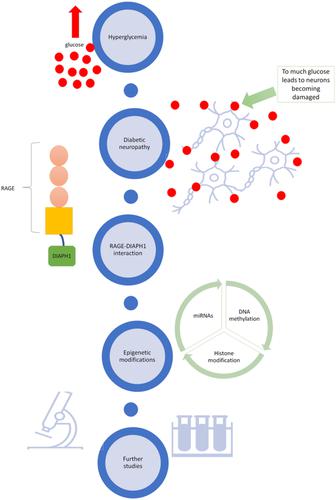当前位置:
X-MOL 学术
›
Eur. J. Neurosci.
›
论文详情
Our official English website, www.x-mol.net, welcomes your
feedback! (Note: you will need to create a separate account there.)
The cross-talk between RAGE and DIAPH1 in neurological complications of diabetes: A review
European Journal of Neuroscience ( IF 2.7 ) Pub Date : 2021-08-27 , DOI: 10.1111/ejn.15433 Kamila Zglejc-Waszak 1 , Konark Mukherjee 2 , Judyta Karolina Juranek 1
European Journal of Neuroscience ( IF 2.7 ) Pub Date : 2021-08-27 , DOI: 10.1111/ejn.15433 Kamila Zglejc-Waszak 1 , Konark Mukherjee 2 , Judyta Karolina Juranek 1
Affiliation

|
Neuropathy, or dysfunction of peripheral nerve, is one of the most common neurological manifestation in patients with diabetes mellitus (DM). DM is typically associated with a hyperglycaemic milieu, which promotes non-enzymatic glycation of proteins. Proteins with advanced glycation are known to engage a cell-surface receptor called the receptor for advanced glycation end products (RAGE). Thus, it is reasonable to assume that RAGE and its associated molecule-mediated cellular signalling may contribute to DM-induced symmetrical axonal (length-dependent) neuropathy. Of particular interest is diaphanous related formin 1 (DIAPH1), a cytoskeletal organizing molecule, which interacts with the cytosolic domain of RAGE and whose dysfunction may precipitate axonopathy/neuropathy. Indeed, it has been demonstrated that both RAGE and DIAPH1 are expressed in the motor and sensory fibres of nerve harvested from DM animal models. Although the detailed molecular role of RAGE and DIAPH1 in diabetic neurological complications remains unclear, here we will discuss available evidence of their involvement in peripheral diabetic neuropathy. Specifically, we will discuss how a hyperglycaemic environment is not only likely to elevate advanced glycation end products (ligands of RAGE) and induce a pro-inflammatory environment but also alter signalling via RAGE and DIAPH1. Further, hyperglycaemia may regulate epigenetic mechanisms that interacts with RAGE signalling. We suggest the cumulative effect of hyperglycaemia on RAGE–DIAPH1-mediated signalling may be disruptive to axonal cytoskeletal organization and transport and is therefore likely to play a key role in pathogenesis of diabetic symmetrical axonal neuropathy.
中文翻译:

RAGE 和 DIAPH1 在糖尿病神经系统并发症中的相互影响:综述
神经病变或周围神经功能障碍是糖尿病 (DM) 患者最常见的神经系统表现之一。DM 通常与高血糖环境有关,该环境促进蛋白质的非酶促糖化。已知具有晚期糖基化的蛋白质与称为晚期糖基化终产物受体 (RAGE) 的细胞表面受体结合。因此,可以合理地假设 RAGE 及其相关分子介导的细胞信号传导可能导致 DM 诱导的对称轴突(长度依赖性)神经病。特别令人感兴趣的是透明相关的 Formin 1 (DIAPH1),这是一种细胞骨架组织分子,它与 RAGE 的胞质域相互作用,其功能障碍可能会导致轴突病/神经病。的确,已经证明 RAGE 和 DIAPH1 在从 DM 动物模型采集的神经的运动和感觉纤维中表达。尽管 RAGE 和 DIAPH1 在糖尿病神经系统并发症中的详细分子作用仍不清楚,但在这里我们将讨论它们参与周围糖尿病神经病变的现有证据。具体来说,我们将讨论高血糖环境如何不仅可能提高晚期糖基化终产物(RAGE 的配体)并诱导促炎环境,而且还可能通过 RAGE 和 DIAPH1 改变信号传导。此外,高血糖可能调节与 RAGE 信号相互作用的表观遗传机制。
更新日期:2021-09-21
中文翻译:

RAGE 和 DIAPH1 在糖尿病神经系统并发症中的相互影响:综述
神经病变或周围神经功能障碍是糖尿病 (DM) 患者最常见的神经系统表现之一。DM 通常与高血糖环境有关,该环境促进蛋白质的非酶促糖化。已知具有晚期糖基化的蛋白质与称为晚期糖基化终产物受体 (RAGE) 的细胞表面受体结合。因此,可以合理地假设 RAGE 及其相关分子介导的细胞信号传导可能导致 DM 诱导的对称轴突(长度依赖性)神经病。特别令人感兴趣的是透明相关的 Formin 1 (DIAPH1),这是一种细胞骨架组织分子,它与 RAGE 的胞质域相互作用,其功能障碍可能会导致轴突病/神经病。的确,已经证明 RAGE 和 DIAPH1 在从 DM 动物模型采集的神经的运动和感觉纤维中表达。尽管 RAGE 和 DIAPH1 在糖尿病神经系统并发症中的详细分子作用仍不清楚,但在这里我们将讨论它们参与周围糖尿病神经病变的现有证据。具体来说,我们将讨论高血糖环境如何不仅可能提高晚期糖基化终产物(RAGE 的配体)并诱导促炎环境,而且还可能通过 RAGE 和 DIAPH1 改变信号传导。此外,高血糖可能调节与 RAGE 信号相互作用的表观遗传机制。











































 京公网安备 11010802027423号
京公网安备 11010802027423号